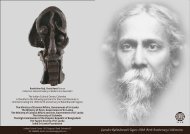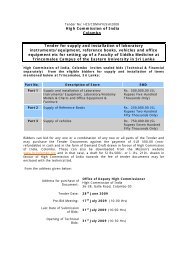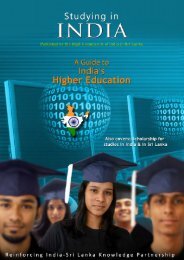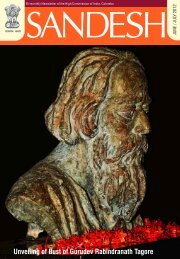Remembering Rabindranath Tagore Volume - High Commission of ...
Remembering Rabindranath Tagore Volume - High Commission of ...
Remembering Rabindranath Tagore Volume - High Commission of ...
You also want an ePaper? Increase the reach of your titles
YUMPU automatically turns print PDFs into web optimized ePapers that Google loves.
13<br />
<strong>Remembering</strong> <strong>Rabindranath</strong> <strong>Tagore</strong><br />
who belong to the underprivileged sections <strong>of</strong> society. He represents the new social<br />
consciousness <strong>of</strong> educated Bengalis <strong>of</strong> this period, and the emerging spirit <strong>of</strong> individualism<br />
characteristic <strong>of</strong> the time (Sogani 88). His opposition to Mahendra’s adulterous love for<br />
Binodini suggests a conservative, didactic mindset; yet his desire to marry the widowed<br />
Binodini also indicates a liberal outlook and a progressive social awareness. In the tussle<br />
between reason and passion, Bihari finds himself unable to live up to his own ideal <strong>of</strong><br />
moral duty. He first falls in love with Asha, another man’s wife, and then feels drawn by<br />
Binodini’sseductive charm. It is this ambivalence that gives his character the psychological<br />
complexity that defines the modernity <strong>of</strong> <strong>Tagore</strong>’s approach in Chokher Bali.<br />
The central, and most complex figure, <strong>of</strong> course, is Binodini. She confounds the distinctions<br />
between prachina and nabina created by Bankimchandra in his classification <strong>of</strong> nineteenth<br />
century women. Instead, she “is an intriguing amalgam <strong>of</strong> the various types <strong>of</strong> Bengali women<br />
that Chatterjee has put into exclusive compartments” (Panja 217). Contrary to the image<br />
<strong>of</strong> the pure, chaste “bhadramahila” or respectable upper-class woman, Binodini assertively<br />
expresses her individual needs and desires. Though a transgressive figure in the first part <strong>of</strong><br />
the novel, Binodini is transformed by her love for Bihari, and ultimately chooses to withdraw<br />
into a life <strong>of</strong> austerity (Sogani 66). According to Dipesh Chakrabarty, the body, as a site for<br />
the struggle between opposite tendencies is an unresolved problem in the text (Chakrabarty<br />
74). He argues that rup or physical beauty is not an issue in Chokher Bali (Chakrabarty 71).<br />
Most readers would agree, though, that Binodini’s character is actually endowed with a strong<br />
element <strong>of</strong> physical allure (Panja 219). She isboth thesubject and the object <strong>of</strong> desire, a selfconscious<br />
target <strong>of</strong> the male gaze, but also driven by her own passion for Bihari. But her<br />
desire cannot be explained in terms <strong>of</strong> the Freudian paradigm <strong>of</strong> the triangular relationship<br />
between father, mother and child. Binodini’s desire is fanned by the repressive social practices<br />
<strong>of</strong> nineteenth century Bengal, and it does not fit the models provided by Western theory.<br />
The modernity <strong>of</strong> <strong>Tagore</strong>’s text demands a different reading frame.<br />
Having created such a subversive figure, though, <strong>Tagore</strong> seemed at a loss to find an<br />
appropriate resolution to her predicament. The fact that he twice changed the ending <strong>of</strong><br />
the novel indicates his own dissatisfaction with the story’s denouement. The disruption<br />
triggered by Binodini’s entry into the lives <strong>of</strong> Mahendra and Bihari allowed <strong>of</strong> no neat<br />
solution in the social milieu within which their narrative is embedded. Though the narrative<br />
ends in reconciliation, Binodini’s departure into oblivion at the end <strong>of</strong> the text leaves us<br />
with the sense <strong>of</strong> a tale left unfinished. But then, fragments and open endings are also<br />
features <strong>of</strong> the modern novel.<br />
Works Cited<br />
Bhattacharya, Anuttam. Rabindra Rachanabhidhan (Bengali) Vol. 7. Kolkata: Deep Prakashan, 2007.<br />
Bhattacharya, Prabhatkumar and Uma Bhattacharya. Adhunikatar Ruppratima vol. 1 (Bengali).<br />
Kolkata: D. N. Publications, 1991.

















